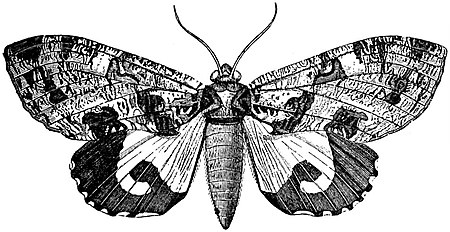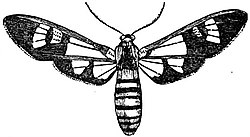exceptional condition—and are protected by a cocoon of silk mixed
with some of the larval hairs, while the female sheds some hairs
from her own abdomen to cover the eggs. The family is widely
distributed, its headquarters being the eastern tropics. To that
part of the world is restricted the allied family of the Hypsidae,
distinguished from the “tussocks” by the slender upturned terminal
segment of the labial palps and by the development of the maxillae.

|
| Fig. 32.—Ophideres imperator. Madagascar.
|

|
| Fig. 33.—Cyligramma fluctuosa. W. Africa.
|
The Noctuidae are the largest and most dominant family of the
Lepidoptera, comprising some 10,000 known species. They are
mostly moths of dull coloration, flying at dusk or by night. The
maxillae are well developed, the hindwing has a frenulum, and its
sub-costal nervure
touches the radial
near the base. The
larvae of the Noctuidae
(fig. 34, c) are
rarely hairy and the
pupa (fig. 34, d)
usually rests in an
earthen cell, being
often the wintering
stage for the species;
sometimes the pupa
is enclosed in a loose
cocoon of silk and
leaves. In some
Noctuidae (fig. 32)
the hindwings are
brightly coloured, but these are concealed beneath the dull, inconspicuous
forewings when the insect rests (fig. 34, f). Nearly
allied to the Noctuidae, but very different in appearance, are the
gaily-coloured Agaristidae, a family of day-flying moths (figs. 35, 36),
confined to the warmer regions of the globe and distinguished by
their thickened feelers, those of the Noctuids being thread-like or
slightly pectinate.

|
| From Mally, Bull. 24, Div. Ent. U.S. Dept. Agr.
|
|
Fig. 34.—e, f, Heliothis armigera. Europe, c, Larva; d, pupa in
cell. Natural size. a, b, Egg, highly magnified.
|
The Arctiidae (tiger moths, footmen, &c.) are allied to the Noctuidae,
but their wing-neuration is more specialized, the sub-costal
nervure of the hindwing being confluent with the radial for the basal
part of its course. These moths (fig. 37) have gaily coloured wings,
and the caterpillars are often densely covered with long smooth
hairs. The pupae are enclosed in silken cocoons (fig. 38). The
highest specialization of structure in this group of the Lepidoptera
is reached by the Syntomidae, a family nearly allied to the Arctiidae,
but with the sub-costal nervure in the hindwing absent. The
Syntomidae have elongate narrow forewings and short hindwings,
usually dark in colour with clear spots and dashes destitute of
scales (fig. 40). The body, on the other hand, is often brilliantly
adorned. The family, abundant in the tropics of the Old World,
has only two European species.

|
| Fig. 35.—Rothia pales. Madagascar.
|

|
|
Fig. 36.—Aegocera rectilinea.
Tropical Africa.
|
|

|
|
Fig. 37.—Haploa Lecontei.
N. America.
|
|
This group includes a series of families which agree with the
Noctuides in most points, but are distinguished by the origin of the
second median nervure of the forewing close to the first, or from
the discocellular nervure midway between the first and third medians
(see fig. 5). These neurational characters may appear somewhat
insignificant, but such slight though constant distinctions in
structures of no adaptational value may be safely regarded as
truly significant of relationship. Several of the families in this
group have lost the frenulum. In larval and pupal characters the
Sphingides generally resemble the Noctuides, but in some families
there is a reduction in the number of the larval prolegs. The egg
is spherical or flat, upright only in the Notodontidae.

|
| After Lugger, Riley and Howard, Insect Life, vol. 2 (U.S. Dept. Agr.).
|
|
Fig. 38.—c, Tiger Moth (Phragmatobia fuliginosa, Linn.). Europe.
a, Caterpillar; b, cocoon with pupa. Slightly enlarged.
|

|
|
Fig. 39.—Halias
prasinana. Europe.
|
|

|
| Fig. 40.—Euchromia formosa. S. Africa.
|
|
The Notodontidae are stout, hairy moths (figs. 5, 41, 42 a) with
maxillae and frenulum developed. In the larva the prolegs on the
hindmost segment are sometimes modified into pointed outgrowths
which are carried erect when the caterpillar moves about. From
these structures whip-like, coloured processes are protruded by the
caterpillar (fig. 42 b) of the puss moth (Cerura) when alarmed;
these processes are believed to help in “terrifying” the caterpillar’s
enemies. Allied to the Notodontidae are the Cymatophoridae—a
family of moths agreeing with the Noctuidae in appearance and
habits—and the large and important family of the Geometridae.









